Bartow-Pell: A Family Legacy
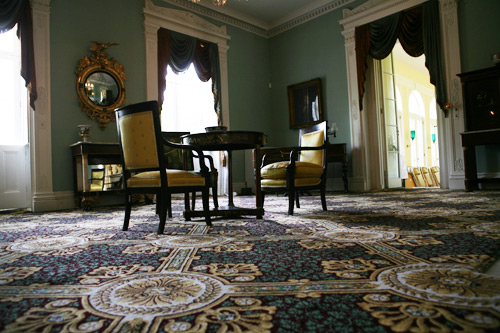
Lesson Plan by:
Sember Weinman, Education Coordinator
Lehman College Art Gallery
Architect:
Minard Lafever, with John Bolton, local carpenter, both friends of the Bartow family.
Curriculum Link:
High School US History and Government (this is a review activity that brings together several units of study)
Unit Two: A:2:a and c The peoples and peopling of the American colonies (voluntary and involuntary)—Native American Indians (relations between colonists and Native American Indians, trade, alliances, forced labor, warfare) and Varieties of immigrant motivation, ethnicities, and experiences.
A:4 The Revolutionary War and the Declaration of Independence
D:1 The Constitution in jeopardy: The American Civil War
7th and 8th Grade Social Studies
I. European Exploration and Settlement
D. Exploration and settlement of the New York State area by the Dutch and English
1. Relationships between the colonists and the Native American Indians
4. Rivalry between the Dutch and English eventually resulting in English supremacy
Project Aim:
Through an investigation of the long history of the Bartow-Pell estate, students discover the far-reaching influence of this family in American history throughout their long occupation of this property. Students will also be able to contextualize history as a series of events that are caused by and effect the lives of real people. Students will be able to imagine the great events of American history through the lens of a family local to the Bronx.
Vocabulary:
Greek Revival: A style of art that was popular in the 19th Century that was a reaction to Baroque Art. This style was derived from the art and culture of ancient Greece and imitated this period’s architecture and fascination for order and simplicity.
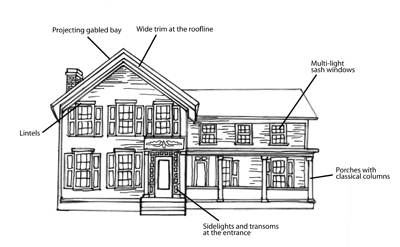 Greek Revival architecture standards
Greek Revival architecture standards
Bartow-Pell Family History:
Thomas Pell was born in England in 1613. He was the son of a distinguished preacher and teacher, Rev. John Pell, D.D. Thomas Pell traveled to America when he was a young man and married Lucy French in 1647; they lived in Fairfield, Connecticut.
Thomas Pell lived during the time that the English and Dutch were fighting for control over the colonies. The English Colony in Connecticut claimed the territory as far west as Pennsylvania. The Dutch claimed territory from New York City to Norwalk, Connecticut. Their claims therefore were overlapping. The English Colony in Connecticut was instrumental in having “Mr. Thomas Pell, Esq. of Fairfield” make the Treaty with the Siwanoy Indians, on November 14, 1654, because it blocked the Dutch. It is debated whether or not Thomas Pell ever built a home on this land. His primary residence was in Connecticut. His purchase of the land was clearly a political move in support of England.
This treaty conveyed to Thomas Pell the lands east of the Hutchinson River to Mamaroneck, including City Island, Hunter’s Island, Travers Island and all the other islands bordering the shore. On the mainland, the tract included Pell’s Point, all the Pelhams, and New Rochelle. West of the River it included the Town of East Chester, part of Mt. Vernon, and part of the Bronx.
The estate was willed to Thomas Pell’s sole heir, Sir John Pell, who was born in England, and worked in the king’s court. He settled in Pelham, and worked to build a road from New York to New England. He built the original estate on this land. This manor house was lived in from 1675 to 1790 by four generations of Pells.
The Pells were British Loyalists. During the Revolutionary War, the family fled to New York City for British protection, leaving the estate vacant. The original house was burned during this time.
 Thomas Pell’s Treaty Oak branch at the Bartow Pell Mansion Museum
Thomas Pell’s Treaty Oak branch at the Bartow Pell Mansion Museum
In 1790 John Bartow, a family descendent, acquired the estate and lived there until 1813. It is believed that he rebuilt his house on the old foundation of the original estate.
The estate remained with the Pell family until it was sold to Herman LeRoy in 1813. It was sold back to Robert Bartow, grandson of John Bartow and Ann Pell in 1836. Robert Bartow built a completely new estate between 1836 and 1842. This house was built in the Greek Revival style, which was popular in this time period. The estate was built in a slightly different location than the original foundation, which can still be found on the property.
The house was sold to the City of New York in 1888, to be developed as park space. In 1914, The Garden Club restored the house and the surroundings. It is now a historical site open to the public.
Why use architecture? What can it teach us?
Art is part of the complex structure of beliefs and rituals, social and political systems, and the stories of every human society. In architecture, the structure, function, and purpose of a building are fused seamlessly with the aesthetic, social, and political preferences of a particular time and place. The purpose for a building’s use determines its size, its shape, and the materials chosen. The value that a society places on that purpose is reflected in the decoration, the scale, and the amount of time taken to create a building. Architects choose to borrow styles from the past as their interpretation of a particular philosophy or ideal. Buildings embody cultural values in every tile or stone.
Time Required:
Six class periods plus research that will be conducted as homework.
SESSION ONE:
Students review American history from the time of Thomas Pell in 1630 to the time that the Bartow-Pell mansion was turned into a park space in 1914.
Objective:
Students will be able to create a list of key historical events that occurred during this time period.
Do Now:
Students respond to the following question, written on the board prior to class: “If you were to choose a historical event to live through, which one would you choose and why?”
Materials:
Notebooks, history textbooks
Activity:
Ask students to look through their notes and textbooks to create a list of the top ten most important historical events in American history since 1630. For each event, ask students to write down three reasons why it is significant. Students read the Bartow Pell Family History and make a list of key family events.
Homework:
Ask students to imagine that they are part of the historical event that they chose in the “Do Now.” Ask them to write an account of the event from the point of view of a person participating in the event at the time.
SESSION TWO:
Students visit the Bartow-Pell Mansion where they learn about the Bartow-Pell family history and see both the family mansion and the location where Thomas Pell bought 50,000 acres from the Siwanoy Indians in 1654.
Objective:
Students will be able to understand the social status, power, and influence of the Bartow-Pell family by observing features of the present Bartow-Pell Mansion and learning about this family’s actions.
 View of the Bartow Pell Mansion and Gardens
View of the Bartow Pell Mansion and Gardens
Materials:
Notebooks and pencils for taking notes and drawing sketches.
Activity:
Students tour the Bartow-Pell Mansion and grounds. They visit the site where Thomas Pell signed the treaty that granted him ownership of 50, 000 acres of land, the main house, the carriage house, and the gardens. Students take notes and draw sketches of each place that they visit.
Homework:
Students do an internet search on Greek Revival Architecture. Alternatively, a handout can be given to them if they do not have access to the internet.
SESSION THREE:
Students begin construction of their own accordion-fold time-line artist books.
Objective:
Students will be able to create a storyboard showing a timeline of major events in American history from 1630 to 1914 and the events of the Bartow-Pell family within the larger span of time. Students will further be able to show both levels of events together to create an effective display.
Do Now:
Students respond to the following prompt, written on the board prior to class: “Imagine that you are a member of the Bartow-Pell family. Write a diary entry for this person.”
Materials:
paper, pencils, (optional) images of artist books projected for students to see.
Activity:
Students are told that they are going to make accordion-fold artist books. They are told that an artist book is a one of a kind art object that incorporates pages of two-dimensional art into a three-dimensional structure. Artist books also include sequence. An internet search on Artist Books can provide some images to give students ideas.
Tell students that the first step is to create a storyboard. A storyboard is a rough layout for each page of the book. This way the students know how many pages they will need; gives them an opportunity to edit their writing; and allows them to think about different ways to include all the information required.
 Sample storyboard
Sample storyboard
Set up guidelines for the students. In their books they must include:
1. A clear timeline of American historical events.
2. A clear description of key events that took place during the Bartow-Pell family history.
3. Clear descriptions of how American historical events affected the Bartow-Pell family.
4. A description of the architecture of the Bartow-Pell Mansion.
5. Two drawings based on their visit to Bartow-Pell
6. An image taken from a handout received at the Bartow-Pell Mansion
7. An imagined journal entry from one of the Bartow-Pell family members.
8. A map
Remind students that the storyboards are a draft version of their books, and not the final version. They therefore should save all materials for the final book pages, and should not glue anything into their storyboards.
Homework:
Ask students to bring in any materials from home that they think might be interesting and appropriate additions to their artist books.
SESSION FOUR:
Students will construct their books. They will make their covers, and design and illustrate each page.
Objective:
Students will be able to successfully construct an accordion-fold artist book to clearly show their knowledge of both significant events in American history, and how the Bartow-Pell family interacted with these events.
Materials:

18” x 24” paper cut into 6” x 24” strips (two or three strips per student), chipboard (cereal boxes will work) cut into 6 ½” squares, construction paper cut into 8” squares, glue sticks, scissors.
Do Now:
Students respond to the following questions, written on the board prior to class: “What important historical events have occurred in your own lifetime? How do you know that these events are significant?”
Activity:
Demonstrate this process as the students work. Students will create their book covers by gluing their chipboard squares into the center of their pieces of construction paper. They will then cut the corners from the construction paper, leaving 1/16th of an inch between the cut corner and the cardboard. The overhanging flaps are then folded and glued down. Repeat for the back cover.Students will then determine the number of pages that they need for their artist books. They will fold their strips of paper into half and then into quarters.
Additional pages can be added by folding a second strip. The last page of the first strip can be glued to the first page of the second strip. Tell students to make sure that they have the number of pages that they need for their timelines. Students should have an even number of pages so that their books open correctly. Students can then glue their book block (pages) to the inside covers of their books.
Students can now begin creating their final timelines, incorporating all required elements of both American history and Bartow-Pell family history.
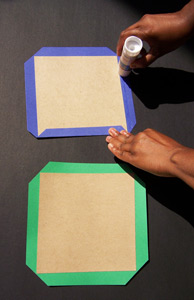 Wraping the covers
Wraping the covers
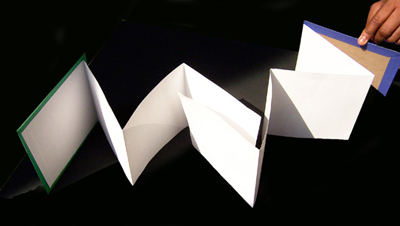 Connecting two paper strips
Connecting two paper strips
SESSION FIVE:
Students complete their artist books.
Objective:
Students will be able to complete their artist books, incorporating all requirements onto the pages. They will also be able to create a cover that includes a title and a symbol that represents the information inside.Materials:
Artist books that were constructed during session 4, colored pencils, materials collected by students from home and at the Bartow-Pell Mansion, magazines, scissors, glue.Do Now:
Students respond to the following prompt, written on the board prior to class: “Think of a symbol that represents either American history, the Bartow-Pells, or both. Make a drawing of your symbol, and write a brief explanation of why this picture is symbolic.Activity:
Students spend the rest of the class completing their artist books. They may be encouraged to use letters cut from magazines in creating their title on the cover of their books.
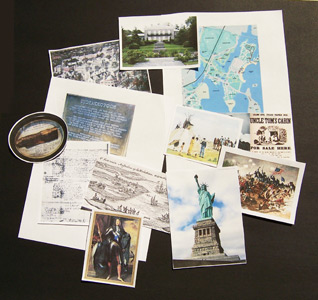 Sample of printed material collected
Sample of printed material collected
Homework:
If students need more time, they may complete their books at home for homework.
SESSION SIX:
Books are displayed around the room and students critique each other’s work.
Objective:
Students will be able to critically assess the success of their fellow classmate’s artist books.Materials:
Completed artist books, assessment worksheet, pens or pencilsDo Now:
Students respond to the following questions, written on the board prior to class: “What grade do you think you deserve for your artist book? Why do you think so?”Activity:
Each student completes an assessment handout while studying a classmate’s artist book. Each student will review the artist books of three other students. At the end of class each student reads the assessments written and writes an assessment of his or her own book. Finished artist accordion book
Finished artist accordion book
ASSESSMENT:
At the end of the workshop, students turn in their artist books, the three assessments generated by other students, and the self-assessments. Develop a rubric based on the assessment page that accounts for all the requirements of the project.
EXTENSIONS:
1. Students can use ideas from the assessment worksheets to add to or change their artist books.
2. Students can choose one key event in the history of the Bartow-Pell family and write a paper on the effect that this moment had on American History.
3. Students can turn their research on the Greek Revival style into a paper comparing this American movement to the architecture of ancient Greece.
4. Students can research the history of the Siwanoy Indians. They can create an artist book depicting early American history from the Indians point of view.
RESOURCES FOR RESEARCH:
Web
American Memory Project, U.S. Library of Congress
http://memory.loc.gov
Bartow-Pell Mansion Museum
http://www.bartowpellmansionmuseum.org/index.php
Historic House Trust
http://www.historichousetrust.org/item.php?i_id=27
Historic Pelham
http://www.historicpelham.com
Metropolitan Museum of Art, Timeline of Art History
http://www.metmuseum.org/toah/splash.htm?HomePageLink=toah_l
Books
Honour, H. and Fleming, J. The Visual Arts: A History, New Jersey: Pearson Education, Inc., 2005.
Salvadori, M., Hooker, S. and Ragus, C. The Art of Construction: Projects and Principals for Beginning Engineers and Architects, Chicago: Chicago Review Press, 1990.
White, N. and Willensky, E. AIA Guide to New York City: The Classic Guide to New York’s Architecture (4th Edition), NY: Three Rivers Press, 2000.
STANDARDS:
S.S. Standard 1—History of the United States and New York: Students will learn about American history through a visit to the Bartow-Pell Mansion in the Bronx.
S.S. Standard 2—World History: Students will develop an understanding of the ideas, social and cultural values, beliefs, and history that led to the Dutch English rivalry in the new world, and later, the Greek influence in American Architecture.
S.S. Standard 3—Geography: Students will study the physical and social environments and human systems of America as it was when first settled by Europeans.
S.S. Standard 4—Economics: Students will consider the economic structures and controls in place in the Bronx from the 17th Century through to the 19th Century, by studying the Bartow-Pell family and their relations.
S.S. Standard 5—Civics, Citizenship, and Government: Students will learn about the reigning political systems of the United States from the 17th Century through the 19th Century; and the different assumptions on power, authority, governance, and law held by the people living during both of these times.
Blueprint Strand 1—Arts Making: Students will learn how to assemble an artist book, as well as techniques and methods for collage and assemblage.
Blueprint Strand 2—Literacy In the Arts: Students become familiar with the vocabulary and important considerations implicit in architecture.
Blueprint Strand 3—Making Connections: Students apply their understanding of both Greek Revival and ancient Greek architecture to interpret the history within which these structures were created.
Blueprint Strand 4—Community and Cultural Resources: Students take advantage of their access to Bronx architectural sites to better understand the purpose and power of architecture both historically and artistically.
Blueprint Strand 5—Careers and Lifelong Learning: Students will obtain exposure to architecture and art history as potential career paths.
ASSESSMENT WORKSHEET:
Analyze and assess three artist books that are not your own. On your own sheet of paper, answer every question for each artist book. After you read other students’ comments on your own work, write a self-assessment. For each assessment, respond to every part of every question below:
Name of Artist:
Does the artist book include:
1. A clear timeline of American historical events?
2. A clear description of key events that took place during the Bartow-Pell family history?
3. Clear descriptions of how American historical events affected the Bartow-Pell family?
4. A description of the architecture of the Bartow-Pell mansion?
5. Two drawings based on their visit to Bartow-Pell?
6. An image taken from a handout received at the Partow-Pell mansion?
7. An imagined journal entry from one of the Bartow-Pell family members?
8. A map?
9. A symbol on the cover?
10. An appropriate title?
Do you think the artist was successful in designing and implementing:
1. The pages of the book?
2. The cover of the book?
3. The symbol for the book?
Why or why not?
What questions do you have for the artist? Is anything unclear?
What suggestions do you have to help this artist if he or she were to continue working on this book? For self-assessment—what would you do differently/add/or change if you had the chance?
